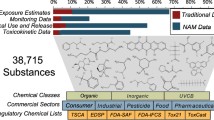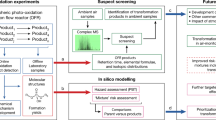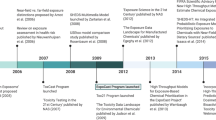Abstract
Currently it is difficult to prospectively estimate human toxicokinetics (particularly for novel chemicals) in a high-throughput manner. The R software package httk has been developed, in part, to address this deficiency, and the aim of this investigation was to develop a generalized inhalation model for httk. The structure of the inhalation model was developed from two previously published physiologically based models from Jongeneelen and Berge (Ann Occup Hyg 55:841–864, 2011) and Clewell et al. (Toxicol Sci 63:160–172, 2001), while calculated physicochemical data was obtained from EPA’s CompTox Chemicals Dashboard. In total, 142 exposure scenarios across 41 volatile organic chemicals were modeled and compared to published data. The slope of the regression line of best fit between log-transformed simulated and observed blood and exhaled breath concentrations was 0.46 with an r2 = 0.45 and a root mean square error (RMSE) of direct comparison between the log-transformed simulated and observed values of 1.11. Approximately 5.1% (n = 108) of the data points analyzed were >2 orders of magnitude different than expected. The volatile organic chemicals examined in this investigation represent small, generally lipophilic molecules. Ultimately this paper details a generalized inhalation component that integrates with the httk physiologically based toxicokinetic model to provide high-throughput estimates of inhalation chemical exposures.
This is a preview of subscription content, access via your institution
Access options
Subscribe to this journal
Receive 6 print issues and online access
$259.00 per year
only $43.17 per issue
Buy this article
- Purchase on Springer Link
- Instant access to full article PDF
Prices may be subject to local taxes which are calculated during checkout




Similar content being viewed by others
Change history
08 February 2021
A Correction to this paper has been published: https://doi.org/10.1038/s41370-020-0248-9
References
Scialla M. It could take centuries for EPA to test all the unregulated chemicals under a new landmark bill. PBS NewsHour. https://www.pbs.org/newshour/science/it-could-take-centuries-for-epa-to-test-all-the-unregulated-chemicals-under-a-new-landmark-bill (2016). Accessed 21 Feb 2019.
National Toxicology Program. About NTP. https://ntp.niehs.nih.gov/about/index.html (2019). Accessed 21 Feb 2019.
Housenger J. Letter to stakeholders on EPA Office of Pesticide Programs’s Goal to Reduce Animal Testing from Jack E. Housenger, Director Office of Pesticide Programs. Regulations.gov—supporting & related material document. https://www.regulations.gov/document?D=EPA-HQ-OPP-2016-0093-0003. Accessed 21 Feb 2019.
Bessems JG, Loizou G, Krishnan K, Clewell HJ, Bernasconi C, Bois F, et al. PBTK modelling platforms and parameter estimation tools to enable animal-free risk assessment: recommendations from a joint EPAA-EURL ECVAM ADME workshop. Regul Toxicol Pharmacol. 2014;68:119–39.
Boyes WK, Bercegeay M, Krantz T, Evans M, Benignus V, Simmons JE. Momentary brain concentration of trichloroethylene predicts the effects on rat visual function. Toxicol Sci J Soc Toxicol. 2005;87:187–96.
Brochot C, Tóth J, Bois FY. Lumping in pharmacokinetics. J Pharmacokinet Pharmacodyn. 2005;32:719–36.
Nestorov IA, Aarons LJ, Arundel PA, Rowland M. Lumping of whole-body physiologically based pharmacokinetic models. J Pharmacokinet Biopharm. 1998;26:21–46.
Gueorguieva I, Nestorov IA, Rowland M. Reducing whole body physiologically based pharmacokinetic models using global sensitivity analysis: diazepam case study. J Pharmacokinet Pharmacodyn. 2006;33:1–27.
Clewell RA, Clewell HJ. Development and specification of physiologically based pharmacokinetic models for use in risk assessment. Regul Toxicol Pharm. 2008;50:129–43.
Rowland MA, Perkins EJ, Mayo ML. Physiological fidelity or model parsimony? The relative performance of reverse-toxicokinetic modeling approaches. BMC Syst Biol. 2017;11:35.
Clark LH, Setzer RW, Barton HA. Framework for evaluation of physiologically-based pharmacokinetic models for use in safety or risk assessment. Risk Anal. 2004;24:1697–717.
US EPA National Center for Environmental Assessment RTPN, Stanek J. Advances in inhalation gas dosimetry for derivation of a reference concentration (RfC) and use in risk assessment. https://cfpub.epa.gov/ncea/risk/recordisplay.cfm?deid=244650 (2012). Accessed 16 Aug 2019.
Pearce RG, Setzer RW, Strope CL, Wambaugh JF, Sipes NS. httk: R package for high-throughput toxicokinetics. J Stat Softw. 2017;79:1–26.
Wambaugh J, Pearce R, Ring C, Honda G, Sfeir M, Davis J, et al. httk: high-throughput toxicokinetics. https://CRAN.R-project.org/package=httk (2019). Accessed 18 Oct 2019.
Pearce RG, Setzer RW, Davis JL, Wambaugh JF. Evaluation and calibration of high-throughput predictions of chemical distribution to tissues. J Pharmacokinet Pharmacodyn. 2017;44:549–65.
Wetmore BA, Wambaugh JF, Allen B, Ferguson SS, Sochaski MA, Setzer RW, et al. Incorporating high-throughput exposure predictions with dosimetry-adjusted in vitro bioactivity to inform chemical toxicity testing. Toxicol Sci. 2015;148:121–36.
Wang Y-H. Confidence assessment of the Simcyp time-based approach and a static mathematical model in predicting clinical drug-drug interactions for mechanism-based CYP3A inhibitors. Drug Metab Dispos Biol Fate Chem. 2010;38:1094–104.
Centers for Disease Control and Prevention. NHANES 2013–2014: volatile organic compounds (VOCs) and trihalomethanes/MTBE—blood—special sample data documentation, codebook, and frequencies). https://wwwn.cdc.gov/Nchs/Nhanes/2013-2014/VOCWBS_H.htm (2019). Accessed 21 Feb 2019.
Clewell HJ, Gentry PR, Gearhart JM, Covington TR, Banton MI, Andersen ME. Development of a physiologically based pharmacokinetic model of isopropanol and its metabolite acetone. Toxicol Sci. 2001;63:160–72.
Cohen Hubal EA, Wetmore BA, Wambaugh JF, El-Masri H, Sobus JR, Bahadori T. Advancing internal exposure and physiologically-based toxicokinetic modeling for 21st-century risk assessments. J Expo Sci Environ Epidemiol. 2019;29:11–20.
Ng LJ, Stuhmiller LM, Stuhmiller JH. Incorporation of acute dynamic ventilation changes into a standardized physiologically based pharmacokinetic model. Inhal Toxicol. 2007;19:247–63.
Aylward LL, Kirman CR, Blount BC, Hays SM. Chemical-specific screening criteria for interpretation of biomonitoring data for volatile organic compounds (VOCs)-application of steady-state PBPK model solutions. Regul Toxicol Pharm. 2010;58:33–44.
Jongeneelen FJ, Berge WFT. A generic, cross-chemical predictive PBTK model with multiple entry routes running as application in MS Excel; design of the model and comparison of predictions with experimental results. Ann Occup Hyg. 2011;55:841–64.
Price K, Krishnan K. An integrated QSAR-PBPK modelling approach for predicting the inhalation toxicokinetics of mixtures of volatile organic chemicals in the rat. SAR QSAR Environ Res. 2011;22:107–28.
Peyret T, Krishnan K. Quantitative property–property relationship for screening-level prediction of intrinsic clearance of volatile organic chemicals in rats and its integration within PBPK models to predict inhalation pharmacokinetics in humans. J Toxicol. 2012;2012:286079.
Mumtaz MM, Ray M, Crowell SR, Keys D, Fisher J, Ruiz P. Translational research to develop a human PBPK models tool kit-volatile organic compounds (VOCs). J Toxicol Environ Health A 2012;75:6–24.
Olie JDN, Bessems JG, Clewell HJ, Meulenbelt J, Hunault CC. Evaluation of semi-generic PBTK modeling for emergency risk assessment after acute inhalation exposure to volatile hazardous chemicals. Chemosphere. 2015;132:47–55.
Sayre R, Wambaugh J, Grulke C. Database of pharmacokinetic time-series data and parameters for evaluating the safety of environmental chemicals. https://epa.figshare.com/articles/Database_of_Pharmacokinetic_Time-Series_Data_and_Parameters_for_Evaluating_the_Safety_of_Environmental_Chemicals/8023229 (2019). Accessed 17 May 2019.
Sayre RR, Wambaugh JF, Grulke CM. Database of pharmacokinetic time-series data and parameters for 144 environmental chemicals. Sci Data. 2020;7:1–10.
Williams AJ, Grulke CM, Edwards J, McEachran AD, Mansouri K, Baker NC, et al. The CompTox Chemistry Dashboard: a community data resource for environmental chemistry. J Cheminformatics. 2017;9:61.
Mansouri K, Grulke CM, Judson RS, Williams AJ. OPERA models for predicting physicochemical properties and environmental fate endpoints. J Cheminform. 2018;10:10.
Wetmore BA, Wambaugh JF, Ferguson SS, Sochaski MA, Rotroff DM, Freeman K, et al. Integration of dosimetry, exposure, and high-throughput screening data in chemical toxicity assessment. Toxicol Sci J Soc Toxicol. 2012;125:157–74.
Ito K, Houston JB. Comparison of the use of liver models for predicting drug clearance using in vitro kinetic data from hepatic microsomes and isolated hepatocytes. Pharm Res. 2004;21:785–92.
Schmitt W. General approach for the calculation of tissue to plasma partition coefficients. Toxicol Vitro Int J Publ Assoc BIBRA. 2008;22:457–67.
Scott JW, Sherrill L, Jiang J, Zhao K. Tuning to odor solubility and sorption pattern in olfactory epithelial responses. J Neurosci J Soc Neurosci. 2014;34:2025–36.
Fiserova-Bergerova V. Extrapolation of physiological parameters for physiologically based simulation models. Toxicol Lett. 1995;79:77–86.
Obach RS. Nonspecific binding to microsomes: impact on scale-up of in vitro intrinsic clearance to hepatic clearance as assessed through examination of warfarin, imipramine, and propranolol. Drug Metab Dispos Biol Fate Chem. 1997;25:1359–69.
Intagliata S, Rizzo A, Gossman WG. Physiology, lung dead space. In: StatPearls. Treasure Island, FL: StatPearls Publishing; 2019. http://www.ncbi.nlm.nih.gov/books/NBK482501. Accessed 1 Jul 2019.
JLCM Dorne, Renwick AG. The refinement of uncertainty/safety factors in risk assessment by the incorporation of data on toxicokinetic variability in humans. Toxicol Sci J Soc Toxicol. 2005;86:20–6.
US EPA O. CAMEO (Computer-Aided Management of Emergency Operations). US EPA. https://www.epa.gov/cameo (2013). Accessed 21 Feb 2019.
US EPA. Methods for derivation of inhalation reference concentrations and application of inhalation dosimetry (600-8-90-066f) [Internet]. https://www.epa.gov/sites/production/files/2014-11/documents/rfc_methodology.pdf (1994). Accessed 16 Aug 2019.
Kuempel ED, Sweeney LM, Morris JB, Jarabek AM. Advances in inhalation dosimetry models and methods for occupational risk assessment and exposure limit derivation. J Occup Environ Hyg. 2015;12(Suppl 1):S18–S40.
Emond C, Krishnan K. A physiological pharmacokinetic model based on tissue lipid content for simulating inhalation pharmacokinetics of highly lipophilic volatile organic chemicals. Toxicol Mech Methods. 2006;16:395–403.
Chebekoue SF, Krishnan K. A framework for application of quantitative property-property relationships (QPPRs) in physiologically based pharmacokinetic (PBPK) models for high-throughput prediction of internal dose of inhaled organic chemicals. Chemosphere. 2019;215:634–46.
Reilly CA, Yost GS. Chapter 10: Sites of extra hepatic metabolism, Part I: Lung. In: Pearson PG, Wienkers LC, editors. Handbook of drug metabolism. 2nd ed. 2008. https://www.taylorfrancis.com/. Accessed 21 Feb 2019.
National Research Council (US) Committee on Contaminated Drinking Water at Camp Lejeune. Contaminated water supplies at Camp Lejeune: assessing potential health effects. Washington, DC: National Academies Press (US). 2009. http://www.ncbi.nlm.nih.gov/books/NBK215298. Accessed 21 Feb 2019..
Roberts DW. QSAR for upper-respiratory tract irritation. Chem Biol Interact. 1986;57:325–45.
Abraham MH, Sánchez-Moreno R, Gil-Lostes J, Acree WE, Enrique Cometto-Muñiz J, Cain WS. The biological and toxicological activity of gases and vapors. Toxicol Vitr. 2010;24:357–62.
Wetmore BA, Allen B, Clewell HJ, Parker T, Wambaugh JF, Almond LM, et al. Incorporating population variability and susceptible subpopulations into dosimetry for high-throughput toxicity testing. Toxicol Sci J Soc Toxicol. 2014;142:210–24.
Ring CL, Pearce RG, Setzer RW, Wetmore BA, Wambaugh JF. Identifying populations sensitive to environmental chemicals by simulating toxicokinetic variability. Environ Int. 2017;106:105–18.
McNally K, Cotton R, Hogg A, Loizou G. Reprint of PopGen: a virtual human population generator. Toxicology 2015;332:77–93.
Centers for Disease Control and Prevention (CDC). National Center for Health Statistics (NCHS). National Health and Nutrition Examination Survey Data. https://www.cdc.gov/nchs/nhanes/index.htm (2019). Accessed 23 Apr 2019.
Tan Y-M, Liao KH, Clewell HJ. Reverse dosimetry: interpreting trihalomethanes biomonitoring data using physiologically based pharmacokinetic modeling. J Expo Sci Environ Epidemiol. 2007;17:591–603.
Sipes NS, Wambaugh JF, Pearce R, Auerbach SS, Wetmore BA, Hsieh J-H, et al. An intuitive approach for predicting potential human health risk with the Tox21 10k Library. Environ Sci Technol. 2017;51:10786–96.
Sheridan RP, Feuston BP, Maiorov VN, Kearsley SK. Similarity to molecules in the training set is a good discriminator for prediction accuracy in QSAR. J Chem Inf Comput Sci. 2004;44:1912–28.
Sayre R, Wambaugh J, Williams A, Grulke C. A public database supporting evidence-based metabolomics. https://epa.figshare.com/articles/A_public_database_supporting_evidence-based_metabolomics/7056233 (2018). Accessed 17 May 2019.
Tian S, Djoumbou-Feunang Y, Greiner R, Wishart DS. CypReact: a software tool for in silico reactant prediction for human cytochrome P450 enzymes. J Chem Inf Model. 2018;58:1282–91.
Podlewska S, Kafel R. MetStabOn-Online platform for metabolic stability predictions. Int J Mol Sci. 2018;19:1–16.
Acknowledgements
The authors would like to thank Dr. Lisa Sweeney for her review of the material and Dr. Greg Honda for his help in getting oriented to the httk package. The United States Environmental Protection Agency (EPA) through its Office of Research and Development (ORD) funded the efforts of RRS, RGP, MAS, and JFW. The views expressed in this publication are those of the authors and do not necessarily represent the views or policies of the U.S. EPA. Reference to commercial products or services does not constitute endorsement. This project was supported by appointments to the Internship/Research Participation Program at ORD and administered by the Oak Ridge Institute for Science and Education through an interagency agreement between the U.S. Department of Energy and U.S. EPA. Finally, we thank Drs. Elaina Kenyon, Jason Lambert, and Rogelio Tornero-Velez at the U.S. EPA and Dr. Jui-Hua Hsieh at the National Toxicology Program for their helpful internal reviews of the manuscript.
Author information
Authors and Affiliations
Corresponding author
Ethics declarations
Conflict of interest
The authors declare that they have no conflict of interest.
Additional information
Publisher’s note Springer Nature remains neutral with regard to jurisdictional claims in published maps and institutional affiliations.
Supplementary information
Rights and permissions
About this article
Cite this article
Linakis, M.W., Sayre, R.R., Pearce, R.G. et al. Development and evaluation of a high throughput inhalation model for organic chemicals. J Expo Sci Environ Epidemiol 30, 866–877 (2020). https://doi.org/10.1038/s41370-020-0238-y
Received:
Revised:
Accepted:
Published:
Issue Date:
DOI: https://doi.org/10.1038/s41370-020-0238-y
Keywords
This article is cited by
-
Exposure forecasting – ExpoCast – for data-poor chemicals in commerce and the environment
Journal of Exposure Science & Environmental Epidemiology (2022)



